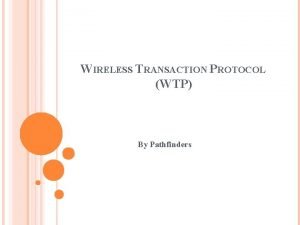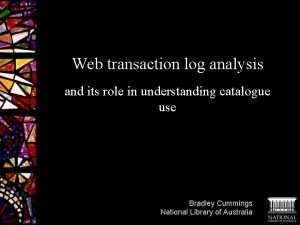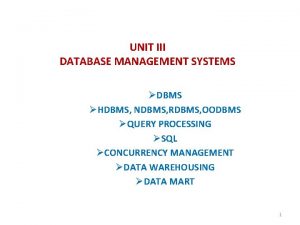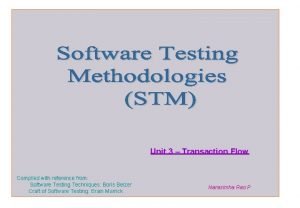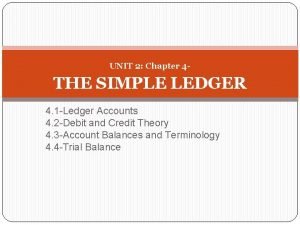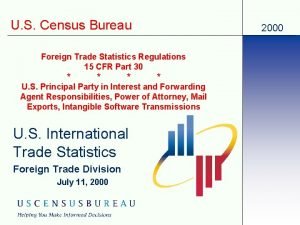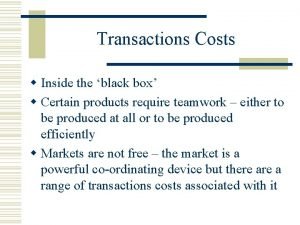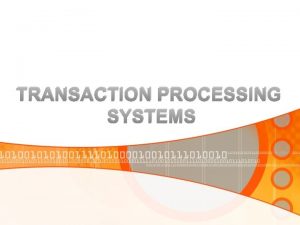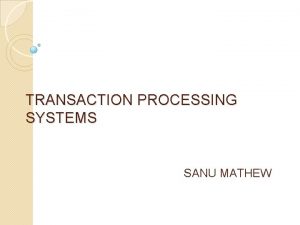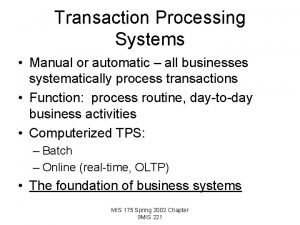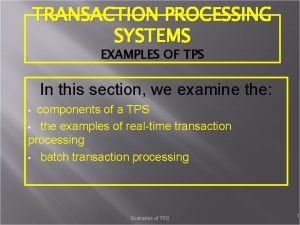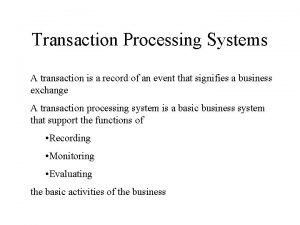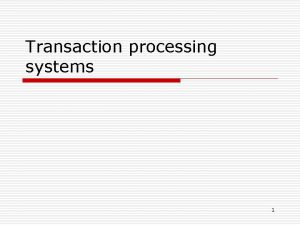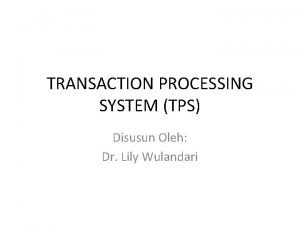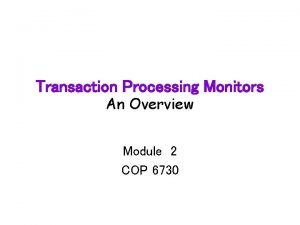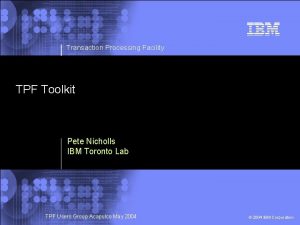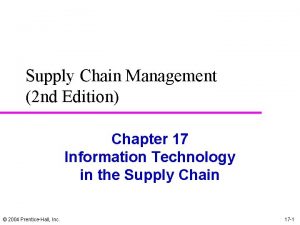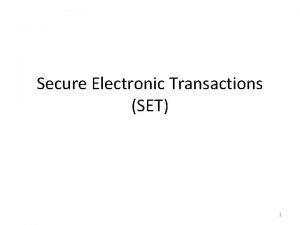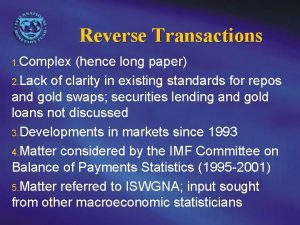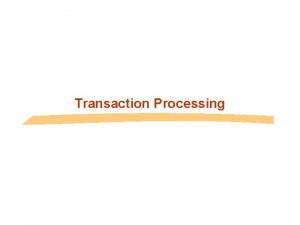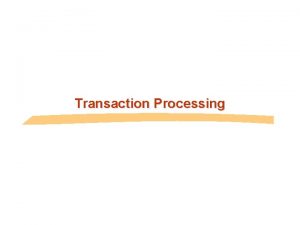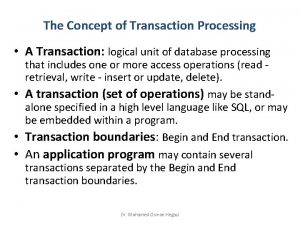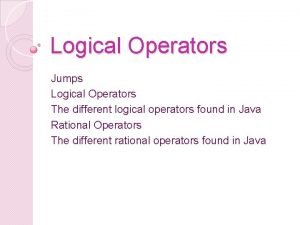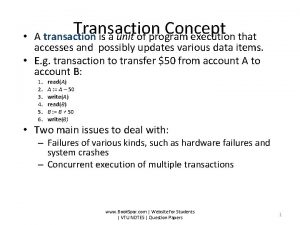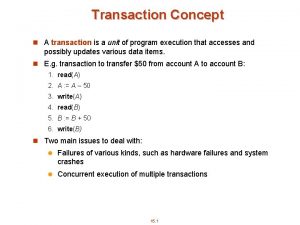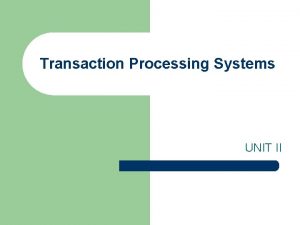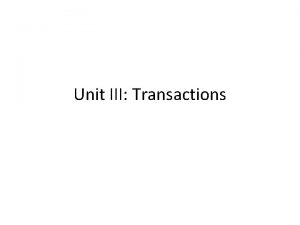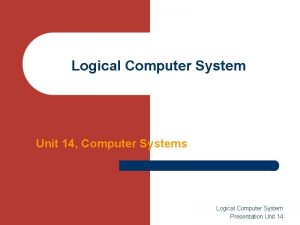9 What is a Transaction Logical unit of

































- Slides: 33

9 What is a Transaction? • Logical unit of work • Must be either entirely completed or aborted • No intermediate states are acceptable Figure 9. 1 Database Systems: Design, Implementation, & Management, 5 th Edition, Rob & Coronel

9 Example Transaction • Examine current account balance SELECT ACC_NUM, ACC_BALANCE FROM CHECKACC WHERE ACC_NUM = ‘ 0908110638’; • Consistent state after transaction • No changes made to Database Systems: Design, Implementation, & Management, 5 th Edition, Rob & Coronel

9 Example Transaction • Register credit sale of 100 units of product X to customer Y for $500 UPDATE PRODUCT SET PROD_QOH = PROD_QOH - 100 WHERE PROD_CODE = ‘X’; UPDATE ACCT_RECEIVABLE SET ACCT_BALANCE = ACCT_BALANCE + 500 WHERE ACCT_NUM = ‘Y’; • Consistent state only if both transactions are fully completed • DBMS doesn’t guarantee transaction represents real-world event Database Systems: Design, Implementation, & Management, 5 th Edition, Rob & Coronel

9 Transaction Properties (ACID) • Atomicity – All or nothing • Consistency provided – Database is consistent before and after transaction – Database not guaranteed consistent during a transaction • Isolation – Transaction data isolated from other transactions until its execution is complete • Durability – Permanently recorded in DB and must be protected Database Systems: Design, Implementation, & Management, 5 th Edition, Rob & Coronel

9 Transaction Management with SQL • Transaction support – COMMIT – ROLLBACK • Transaction begins with a BEGIN TRANSACTION and ends with COMMIT or ROLLBACK • At COMMIT point (synch point) all updates made permanent and locks released • Requires the use of a log or journal Database Systems: Design, Implementation, & Management, 5 th Edition, Rob & Coronel

9 Transaction Log • • Tracks all transactions that update database Needed in ROLLBACK operation May be used to recover from system failure Log stores – Record for beginning of transaction – Each transaction component • • Type of action (insert, delete, update) Names of objects involved Before and after images of affected objects Pointers to previous and next entries – Commit Statement Database Systems: Design, Implementation, & Management, 5 th Edition, Rob & Coronel

9 Transaction Log Example Table 9. 1 Write-ahead Log Rule: Log is physically written before COMMIT completes to enable restart Database Systems: Design, Implementation, & Management, 5 th Edition, Rob & Coronel

9 Checkpoints • How to know at restart time which transactions to undo and which ones to redo? • Checkpoints periodically taken • “Taking a checkpoint” involves force-writing buffers and writing a checkpoint record to the log consisting of all transactions in progress at checkpoint time • For example. . . Database Systems: Design, Implementation, & Management, 5 th Edition, Rob & Coronel

9 Algorithm for Undo/Redo • At restart from checkpoint, set UNDO list to transactions that were in progress at the time • Set REDO list to null • Search forward through log starting from checkpoint • If BEGIN TRANSACTION found, add to UNDO list • If COMMIT found, move from UNDO to REDO Database Systems: Design, Implementation, & Management, 5 th Edition, Rob & Coronel

9 Concurrency Control • Coordinates simultaneous transaction execution in multiprocessing database • Potential problems in multiuser environments – Lost updates – Uncommitted data – Inconsistent retrievals Database Systems: Design, Implementation, & Management, 5 th Edition, Rob & Coronel

Lost Updates 9 Table 9. 2 Normal execution of two transactions Table 9. 3 Lost update Database Systems: Design, Implementation, & Management, 5 th Edition, Rob & Coronel 11

9 Uncommitted Data Table 9. 4 Table 9. 5 Database Systems: Design, Implementation, & Management, 5 th Edition, Rob & Coronel 12

9 Inconsistent Retrievals • Also known as “dirty reads” or “unrepeatable reads” • Occurs when a transaction reads several values, some of which are being updated • Example: T 1 sums the total quantity on hand while T 2 transfers an amount on hand from one item to another (correcting an incorrect posting, for instance) Database Systems: Design, Implementation, & Management, 5 th Edition, Rob & Coronel

9 Inconsistent Retrievals The two transactions T 2 Database Systems: Design, Implementation, & Management, 5 th Edition, Rob & Coronel 14

9 Inconsistent Retrievals Results with interleaved transactions Table 9. 8 Database Systems: Design, Implementation, & Management, 5 th Edition, Rob & Coronel 15

Serializability 9 • It is possible for T 1 followed by T 2 to result in a different state than T 2 followed by T 1 • But both would be correct (consistent) from the DB point of view • Transaction serializability means that transactions executing concurrently must be interleaved in such a way that the resulting DB state is equal to some serial execution of the same transactions • Goal is to avoid the concurrency problems (lost update, uncommitted data, inconsistent retrieval) Database Systems: Design, Implementation, & Management, 5 th Edition, Rob & Coronel

9 The Scheduler • Establishes order of concurrent transaction execution • Interleaves execution of database operations to ensure serializability • Uses a protocol for producing serializable schedules: – Locking – Time stamping – Optimistic • Ensures efficient use of computer’s CPU Database Systems: Design, Implementation, & Management, 5 th Edition, Rob & Coronel

Concurrency Control with Locking Methods • Lock guarantees current transaction exclusive use of data item • Acquire lock prior to access • Lock released when transaction is completed • DBMS automatically initiates and enforces locking procedures • Lock granularity indicates level of lock use Database Systems: Design, Implementation, & Management, 5 th Edition, Rob & Coronel 9

9 Locks • Read (sharing) or Write (exclusive) • At various levels: DB, table, page, row, field • Many Read locks simultaneously possible for a given item, but only one Write lock • Transaction that requests a lock that cannot be granted must wait • Possible to upgrade Read lock to Write lock or downgrade Write lock to Read lock • Locks released at commit point (or earlier) Database Systems: Design, Implementation, & Management, 5 th Edition, Rob & Coronel

9 Shared/Exclusive Locks • Shared (Read) – Exists when concurrent transactions granted READ access – Issued when transaction wants to read and exclusive lock not held on item • Exclusive (Write) – Exists when access reserved for locking transaction – Used when potential for conflict exists – Issued when transaction wants to update unlocked data Database Systems: Design, Implementation, & Management, 5 th Edition, Rob & Coronel

9 Problems with Locking • Transaction schedule may not be serializable – Managed through two-phase locking • Schedule may create deadlocks – Managed by using deadlock detection and prevention techniques Database Systems: Design, Implementation, & Management, 5 th Edition, Rob & Coronel

9 Two-Phase Locking Protocol (2 PL) • Growing phase: acquire all locks needed • Shrinking phase: after releasing a lock, acquire no new locks • Consequently – No unlock operation can precede a lock operation in the same transaction – No data are affected until all locks are obtained • 2 PL solves the 3 problems of concurrency Database Systems: Design, Implementation, & Management, 5 th Edition, Rob & Coronel

9 Two-Phase Locking Protocol Figure 9. 6 Database Systems: Design, Implementation, & Management, 5 th Edition, Rob & Coronel

9 Deadlock • Also called deadly embrace • “Occurs when two transactions wait for each other to unlock data” • Wrong! – eg, T 1 waits for T 2, T 2 waits for T 3, T 3 waits for T 1 • Notation: T 1 T 2 means T 1 waits for data held by T 2 • A system is in deadlock if there is a set of waiting transactions {T 0, T 1, …, Tn} such that T 0 T 1, T 1 T 2, … , Tn T 0 Database Systems: Design, Implementation, & Management, 5 th Edition, Rob & Coronel

Deadlock Detection • Wait-for-graph Database Systems: Design, Implementation, & Management, 5 th Edition, Rob & Coronel 9

Recovery from Deadlock 9 One or more transactions must be aborted 1 Determine transactions to roll back • Want to incur minimum “cost” • May be based on time running, time left, amount of data used, how many transactions are involved in rollback (cascades) 2 Total or partial rollback 3 Starvation • Can happen that same transaction is always chosen as victim • Use the number of times rolled back in determining the cost Database Systems: Design, Implementation, & Management, 5 th Edition, Rob & Coronel

9 Deadlock Prevention • Could require all locks to be acquired at once – but may not always know what is needed – potentially inefficient -- many items locked unnecessarily for possibly long time • Ordering of data items – once a transaction locks an item, it cannot lock anything occurring earlier in the ordering • Preemption and rollback with timestamps – wait-die – wound-wait Database Systems: Design, Implementation, & Management, 5 th Edition, Rob & Coronel

9 Concurrency Control with Time Stamping Methods • Assigns global unique time stamp to each transaction • Produces order for transaction submission • Properties – Uniqueness – Monotonicity • Some time stamping necessary to avoid “livelock”: where a transaction cannot acquire any locks even though the DBMS is not deadlocked (eg, unfair waiting algorithm) Database Systems: Design, Implementation, & Management, 5 th Edition, Rob & Coronel

9 Deadlock Prevention with Time Stamps • Wait-die – If T 1 requests item locked by T 2, then T 1 is allowed to wait only if it is older than T 2 (smaller time stamp). Otherwise T 1 is rolled back (dies) • Wound-wait – If T 1 requests item locked by T 2, then T 1 is allowed to wait only if T 1 is younger than T 2 (larger time stamp). Otherwise T 2 is rolled back (wounded by the older transaction) • Both avoid starvation, since eventually a failing transaction will be the oldest Database Systems: Design, Implementation, & Management, 5 th Edition, Rob & Coronel

Concurrency Control with Optimistic Methods 9 • Assumes most database operations do not conflict • Transaction executed without restrictions until committed • Transactions execute in 3 Phases in order: – Read Phase – Validation Phase – Write Phase • Transactions are still interleaved, but may have to be rolled back Database Systems: Design, Implementation, & Management, 5 th Edition, Rob & Coronel

9 Phases in Validation-based Control • Read phase – Transaction reads data and stores in local variables – Any writes are made to local variables without updating the actual DB • Validation phase – Validation test performed to see whether DB can be changed without violating serializability – Relies on time stamping each transaction at each phase • Write phase – If the validation test is successful, the transaction updates the actual DB. Otherwise it is rolled back. Database Systems: Design, Implementation, & Management, 5 th Edition, Rob & Coronel

9 Database Recovery Management • Restores a database to previously consistent state • Based on the atomic transaction property • Level of backup – Full backup – Differential – Transaction log Database Systems: Design, Implementation, & Management, 5 th Edition, Rob & Coronel

9 Transaction Recovery • Deferred-write and Deferred-update – Changes are written to the transaction log – Database updated after transaction reaches commit point • Write-through – – Immediately updated by during execution Before the transaction reaches its commit point Transaction log also updated Transaction fails, database uses log information to ROLLBACK Database Systems: Design, Implementation, & Management, 5 th Edition, Rob & Coronel
 Logical operators equivalence
Logical operators equivalence Kesetaraan logis
Kesetaraan logis Unit 6 review questions
Unit 6 review questions Wtp pathfinder
Wtp pathfinder Web transaction logs
Web transaction logs Hdbms and ndbms
Hdbms and ndbms Transaction flow testing
Transaction flow testing Chapter 4 the simple ledger answers
Chapter 4 the simple ledger answers Routed export transaction
Routed export transaction 5 types of information system
5 types of information system Market transaction example
Market transaction example Characteristics of tps
Characteristics of tps Transaction processing systems examples
Transaction processing systems examples Manual transaction processing system
Manual transaction processing system An example of
An example of Transaction processing system
Transaction processing system Characteristic of transaction processing system
Characteristic of transaction processing system Tps sistem informasi
Tps sistem informasi Transaction module 2
Transaction module 2 Transaction processing facility
Transaction processing facility Ppp transaction advisory
Ppp transaction advisory Transaction management foundation
Transaction management foundation Exchange transaction and relationship in marketing
Exchange transaction and relationship in marketing Secure electronic transaction
Secure electronic transaction Internet transaction server
Internet transaction server What is reversal transaction
What is reversal transaction Measuring broad economic goals
Measuring broad economic goals Transactional analysis
Transactional analysis Transaction sifac recettes
Transaction sifac recettes Transaction cycle flow chart
Transaction cycle flow chart Ulterior transaction example
Ulterior transaction example Transaction processing system in mis
Transaction processing system in mis Http transaction
Http transaction Transaction management in distributed database
Transaction management in distributed database



